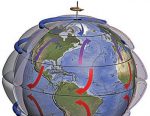
How Have Global Pressures and Winds Affected History in the North Atlantic?
INTERCONTINENTAL TRAVEL AND TRADE have relied upon moving currents in the air and oceans. Before the 20th century, when transoceanic travel and shipping relied on wind power, global winds, such as the trade winds and westerlies, dictated which directions of travel were possible at different latitudes. The directions of global winds therefore greatly influenced the […]
Japan’s Prehistory and Early Mainland Asia Influences
The first people in the archipelago probably walked there via temporary land bridges from the Asian mainland more than 30,000 years ago. There is some archeological evidence that people from Southeast Asia also reached Japan by water in prehistoric times. Archaeologists have used the art of Japan's earliest known culture to name the first period […]
Japan: History
KEY EVENTS IN JAPANESE HISTORY 11,000–300 BCE Jomon culture 300 BCE–250 CE Yayoi culture 250–552 CE Tomb period (Kofun) 552–710 Late Yamato period 552 Buddhism is transported from Korea to Japan 604 Japan's 17-point ''constitution'' is ascribed to Prince Shotoku 645 So-called Taika Reforms are enacted 710 Japan's first permanent capital is established at Nara […]
History
Jamaica has a remarkable and dramatic history, one of merging peoples and cultures. The island's inhabitants enjoy a culture that is a blend of traditions from various groups that have come to the island over time. They include the native Taino Indians, the English colonizers, and Africans who were introduced to the Caribbean to perform […]

Aristotle and His Natural History
Aristotle (384–322 b.c.e.) was a Greek philosopher who lived at a time when most people believed in a world governed by gods, demigods, and other supernatural beings. According to tradition, in the distant past these beings had made the plants and the stories about how they did so are woven into the Greek myths. It […]
Big Bend National Monument: Hard and Historical
This 2,865-square-mile (7,420 sq km) region in a bend of the Rio Grande exemplifies the austere terrain and the complex geological history of the lower-elevation areas of the Chihuahuan Desert. Lying in a great, down-dropped trough, the park features the typical basin and range topography of low flat basins surrounding sharply uplifted, isolated mountain ranges. […]
Grand Canyon Reveals the History of the Earth
The great gash of the Grand Canyon also provides perhaps the single most dramatic lesson in geology and the Earth's history on the planet. The Colorado River cut down through the leading edge of the uplifted Colorado Plateau in the past five million years as the same forces that created the Basin and Range Province […]

Reading history in rocks
All these rocks hold clues to the history of the Earth and, through many years of hard work by hammer-wielding geologists, this information has been painstakingly unlocked. In a saga of endeavour generally traced back to the work of William Smith in early-nineteenth-century England, the geological tale of the Earth has been assembled bed by […]
Ireland: Culture History and Cultural Landscape
Fado, fado, with the end of the Ice Age, 12,000 years ago, the glaciers retreated. They left Ireland covered with glacial debris and tundra vegetation. It was a barren land, with limited varieties of plant and animal life. This is the setting in which Ireland's changing culture history and cultural landscape takes place. Over the […]
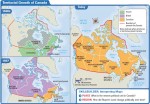
History and Government of Canada
A HUMAN PERSPECTIVE Around A.D. 980, a Viking named Erik the Red sailed to Greenland. Soon after, about 3,000 Vikings colonized the region. About A.D. 1000, Erik's son Leif led an expedition that landed off the Atlantic coast of North America on what is now Newfoundland. Leif called the area Vinland, after the wild grapes […]
History and Government of the United States
A HUMAN PERSPECTIVE Women were North America's first farmers. In all early cultures except the hunter-gatherer culture of the Southwest, women cultivated the land. They discovered which wild plants could be used as food for the family. They planted the seeds, tended the garden, harvested the crops, and prepared food for meals. Corn, beans, and […]
French History to 1830
A deep sense of the past is very much part of French character. Glorious monuments of that dramatic and creative past are revered treasures, the inheritance of the nation. Because of its respect for the past, France exceeds most other countries in its historic-preservation efforts. The history of any country, France included, is made up both of important individual events […]
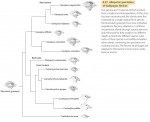
Historical Biogeography
Thus far, we've looked at ecological processes that produce biogeographic patterns at local and regional spatial scales. We now turn to patterns at continental and global scales that develop over longer time periods. Historical biogeography focuses on how these spatial distribution patterns arise over space and time through four key processes: evolution, speciation, extinction, and dispersal. EVOLUTION An astonishing number of […]

Southern Africa, History
The arrival of Europeans in southern Africa in the 1600s set in motion a long period of upheaval that transformed the region. A series of violent conflicts pitted Dutch settlers against indigenous peoples, the Dutch against the British, the British against indigenous peoples, and various African groups against each other. After white settlers discovered gold and diamonds in the 1800s, […]
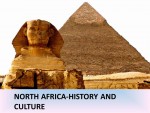
North Africa: History and Cultures
Separated from the rest of Africa by the SAHARA DESERT, the peoples of North Africa share a language and many cultural, political, and economic traditions. The term North Africa refers to the modern states of EGYPT, LIBYA, TUNISIA, ALGERIA, and MOROCCO, as well as the territory of WESTERN SAHARA. In ancient times the lands north of the Sahara and […]
History of Africa
Tracing the history of Africa has presented a challenge to historians because of the lack of written records for much of the continent's past. Until recently most information had come from reports of foreign visitors, traders, and invaders over the last several hundred years. Historians of Asia and Europe, by contrast, have been able to use ancient records to construct […]
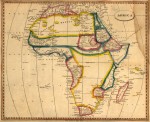
Economic History
Alack of written sources makes it difficult to trace the early economic history of much of the African continent, especially sub-Saharan Africa. What is clear is that Africans in precolonial times had basic economic activities that provided them with the things they needed to survive. At the same time, however, many factors limited the kind of intensive economic development […]
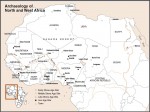
Archaeology and Prehistory
Africa's archaeological heritage is both ancient and rich. Several million years ago, the first ancestors of humans emerged in Africa. About 100,000 years ago, the first modern people appeared there as well. Since that time, a pageant has unfolded across the continent's vast and varied landscapes. Multitudes of cultures have emerged, peoples have migrated, empires have risen and fallen, and […]
History of Animated Maps
The history of animated maps is very much tied to the history of computers. Early examples of animated maps were produced in the 1930s using hand drawn, cel based techniques borrowed from cartoon animation. Because these manual techniques were exceptionally time consuming, academic cartographers and computer scientists started experimenting with the potential of computer assisted animation surprisingly early (late 1950s) and […]
Historical Cartography
A second form of geographical and historical investigation about the past involves maps compiled from data relating to an earlier situation. Interpreted generously as the writing of history with maps rather than words, the practice is older and the reasons for it more diverse than is generally described. In the thirteenth and fourteenth centuries, for example, maps of the world […]
The History of Cartography
The division of the history of cartography into 'old' and 'new' came about in the penultimate decade of the twentieth century. Examples of the use of the word 'cartography' in Germany as early as the second decade of the nineteenth-century have been found, but the idea of a formal history of cartography for the study of old, that is, nonmodern, maps […]
The History of Maps and Mapping
That new approach emerged in the 1980s, propelled by factors both external and internal. External to – one might say foreign to – the world of cartography was the French theoretical and philosophical post structuralist movement led by Michel Foucault and Jacque Derrida that had already found fertile ground in the humanities (including geography) in Europe in the late 1970s. […]
Cartobibliography: The History of Printed Maps
The indispensable step in approaching a map (or anything) to be used as evidence is to check its publication history and its credentials as a source in the same way as a bibliographer examines a book. The discriminating description of maps is known as cartobibliography, a term first used in 1914 by George Fordham in the title of […]
Approaches to the History of Cartography
For geographers, the relationsip between maps and history has taken several forms. The terms used to describe each form are not synonymous; the 'history of cartography' is not the same thing as 'historical cartography' or the 'history of mapping', although in practice the boundaries between the categories of activities noted below are neither precise nor impermeable. Many studies conducted under […]
Cartography, History of
The ubiquity of maps today is beyond dispute. They are treasured as decoration in private and public places, and enjoyed in exhibitions. Whether in manuscript or print, or on television, maps are the workhorses of weather forecasters, reporters, political and cultural commentators, cartoonists, textbook writers, scientific researchers, administrators, and planners alike. As printed road atlases (or, increasingly, electronic satellite navigation systems), they […]

Biodiversity Mapping: History
The mapping of species distributions has a long history in geography. As far back as the early 1800s, Alexander von Humboldt described the latitudinal and altitudinal distributions of vegetation zones, and others continued such practices until methods were eventually formalized within the subdiscipline of biogeography. In other disciplines, too, particularly biology, the notion that place matters in ecological processes and patterns […]
Historical Background
The development of atlases can be divided into different stages. The first stage of atlas development is defined by Ptolemy's Guide to Geography (Geographike hyphegesis), which dates back to the second century AD. In volume 8 of the guide Ptolemy included instructions on how to show the Earth in maps and also included 26 maps. The guide was unknown until […]
Geoarchaeology, Environmental History, and Causality
A very different intersection between anthropology and geography came about in the form of geoarchaeology, another integrative approach. Although geoscience applications to problems of dating, environmental reconstruction, and spatial organization in archaeology are common (mainly as 'archaeological geology'), and rapidly gaining in popularity, direct attention to the nature of the archaeological record is not. That record is a proxy for human […]
Histories of Animal Geographies
Animals have long had a presence in geography as a discipline. In the modern period, two closely related approaches characterized a distinct study of animals in geography. The first became known as zoogeography and sought to map evolutionary distributions of animals and was closely allied to what was to become a more physical geographical approach, allied with zoology and the (then) emerging […]
The Historical Relationship of Anarchism and Geography
The confluence of anarchism as a political philosophy and geography as an emerging discipline occurred in the latter half of the nineteenth-century largely in response to European nation building and growing social inequities. As taught in the halls of European military colleges, geography was often complicit in promoting imperial conquest by mapping resources to benefit European nations. Two prominent dissidents within […]
How Do Agglomerations Emerge and Develop – Historical Approaches
Spatial agglomerations of similar and related economic activity often have deep historical roots. An alternative way to understand the agglomeration phenomenon is to study real agglomerations historically in order to analyze their birth, growth, saturation, decline, and possible reinvigoration. The origin of the agglomeration in such accounts, that is, the event or action which triggered subsequent developments, sometimes turns out to […]

historical geography
GEOGRAPHERS SEEK TO understand the world by examining spatial relationships. The types of questions they might ask are: Why are things located where they are? How are places different from each other? How are places like each other? How are places interconnected with each other? How do people affect their natural environment and how does […]